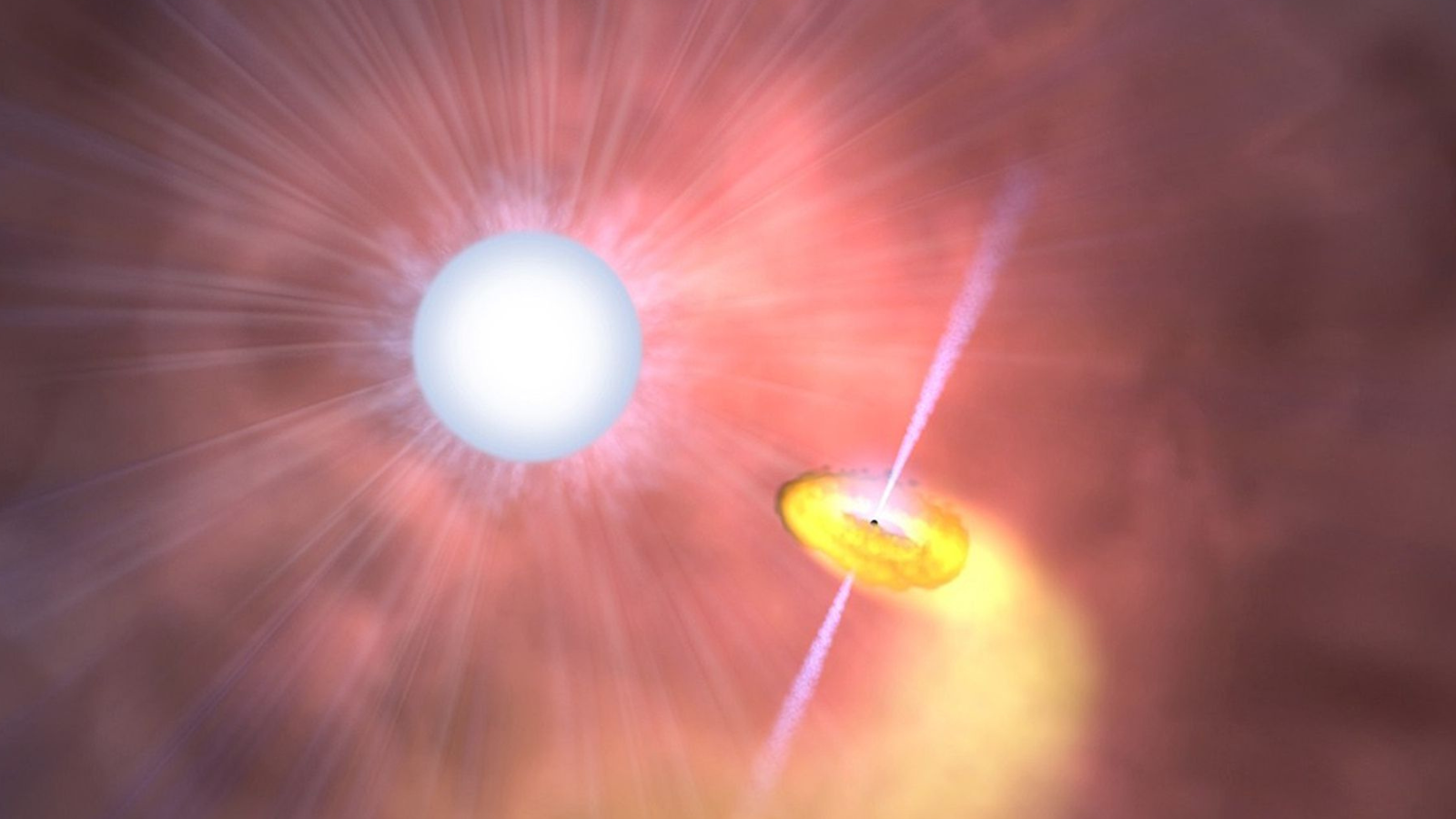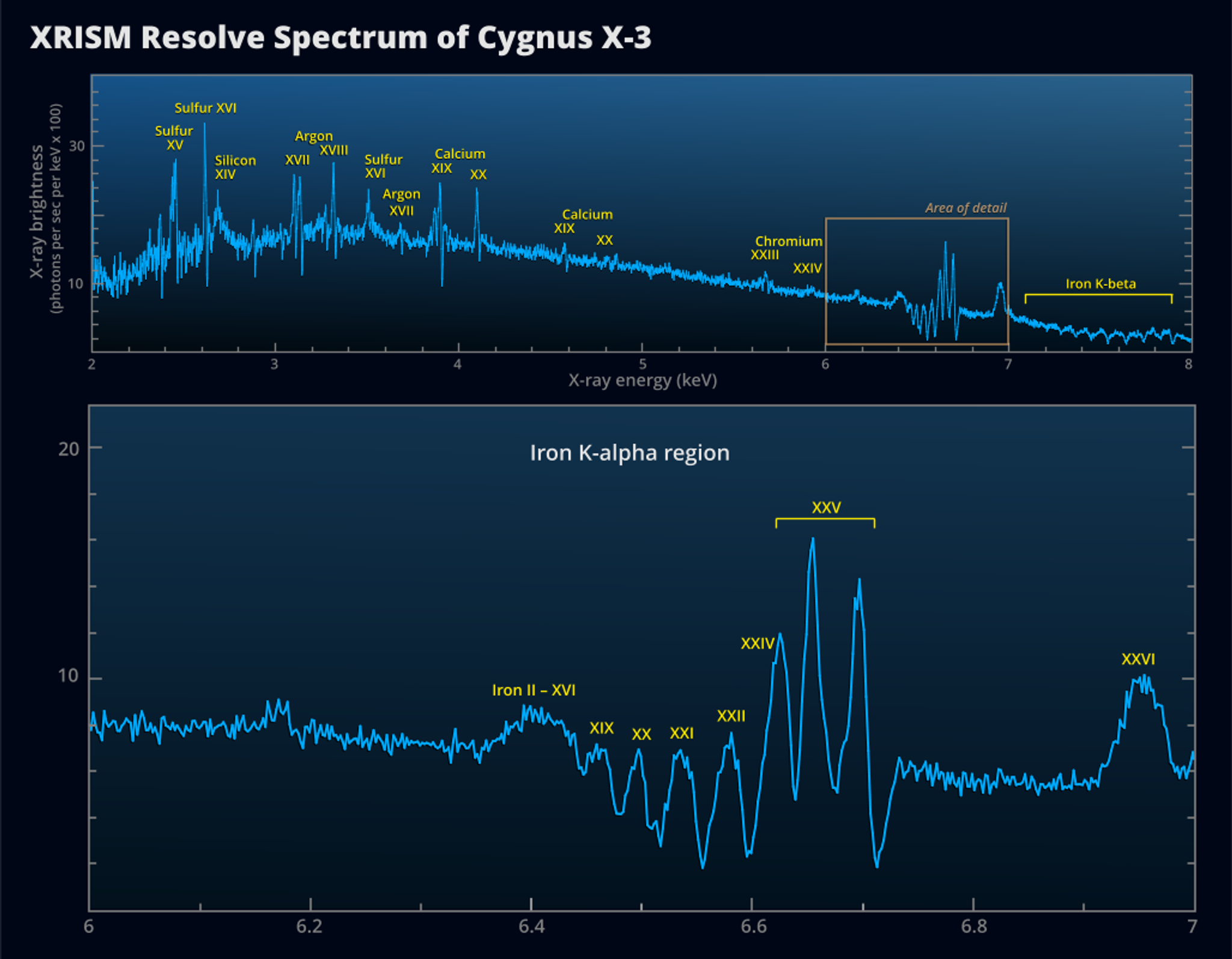'Hidden black hole' devouring curious star exposed by new X-ray space telescope
"For XRISM, Cygnus X-3 is a Goldilocks target."

Using the Japanese-led X-ray Imaging and Spectroscopy Mission (XRISM), astronomers have taken a deep look into a fascinating binary system that is thought to contain a "hidden" black hole and a massive star blowing strong stellar winds.
The X-ray telescope XRISM, operated jointly by the Japan Aerospace Exploration Agency (JAXA) and NASA, created the most detailed map yet of gases flowing through this system, named Cygnus X-3. Cygnus X-3 is located around 32,000 light-years away in the direction of the northern constellation Cygnus, the Swan.
"For XRISM [pronounced "crism"], Cygnus X-3 is a Goldilocks target — its brightness is 'just right' in the energy range where XRISM is especially sensitive," team member and NASA Goddard Space Flight Center astrophysicist Timothy Kallman said in a statement. "This unusual source has been studied by every X-ray satellite ever flown, so observing it is a kind of rite of passage for new X-ray missions."
The two occupants in this system, a suspected black hole and a massive star, are so close together that they complete an orbit around one another in just under 5 hours. This proximity means that the massive star appears to be in the process of being devoured by its compact stellar remnant, which is likely a black hole. Arguably, the most fascinating aspect of Cygnus X-3 is the massive star itself orbiting this mysterious dead stellar remnant.
"The nature of the massive star is one factor that makes Cygnus X-3 so intriguing," team leader and NASA's Goddard Space Flight Center researcher Ralf Ballhausen said in the statement. "It's a Wolf-Rayet star, a type that has evolved to the point where strong outflows called stellar winds strip gas from the star's surface and drive it outward. The compact object sweeps up and heats some of this gas, causing it to emit X-rays."
Winds blow at 1,000 times the speed of sound in Cygnus X-3
X-rays are useful for studying Cygnus X-3 because this system is obscured by thick dust clouds in the central plane of the Milky Way, which absorbs visible light. High-energy light like X-rays and gamma-rays can penetrate these clouds, as can low-energy light like radio waves.
Cygnus X-3 is also shrouded in gas streaming from its massive star occupant. X-rays from around the suspected black hole ionize this gas envelope, causing the material to emit X-rays itself.
Get the Space.com Newsletter
Breaking space news, the latest updates on rocket launches, skywatching events and more!

XRISM studied Cygnus X-3 for around 18 hours in March 2024 using its Resolve instrument. This allowed it to obtain a high-resolution spectrum that reveals the complex gas dynamics at play in Cygnus X-3, including outflowing gas produced by the hot, massive Wolf-Rayet star.
The gas mapping also showed how this gas interacts with the suspected black hole in Cygnus X-3. The team also saw how a turbulent region is generated in Cygnus X-3 that appears to be the result of this compact stellar remnant diving through the gas from the Wolf-Rayet star.

The spectrum observed by XRISM is tough to interpret because some of its peaks and valleys appear to be displaced. This is a result of the gas's rapid motion, which causes wavelengths of light from the gas to be "redshifted" if it is moving away from Earth and "blueshifted" if it is headed toward our planet.
The majority of the gas in Cygnus X-3 is blueshifted, indicating it is moving toward us, with the team of scientists estimating that it is traveling at speeds of around 930,000 miles per hour (1.5 million kilometers per hour). That's around 1,000 times the speed of sound when measured here on Earth.
The data obtained by the XRISM spacecraft indicated that the small amount of gas in Cygnus X-3 that is moving away from Earth is doing so at a much slower speed.
The team also found that features in the spectrum obtained from gas in Cygnus X-3 indicated stronger absorption of photons, the fundamental particles of light, than emission.
Using features produced by ionized iron, Ballhausen and colleagues concluded the dynamics of the stellar wind allow the moving gas of this binary system to absorb a broader range of X-ray energies emitted by the compact stellar remnant in Cygnus X-3 companion.
"A key to acquiring this detail was XRISM's ability to monitor the system over the course of several orbits," NASA's XRISM project scientist Brian Williams said. "There's much more to explore in this spectrum, and ultimately, we hope it will help us determine if Cygnus X-3's compact object is indeed a black hole."
The team's research is set to be published in the Astrophysical Journal.
Join our Space Forums to keep talking space on the latest missions, night sky and more! And if you have a news tip, correction or comment, let us know at: community@space.com.

Robert Lea is a science journalist in the U.K. whose articles have been published in Physics World, New Scientist, Astronomy Magazine, All About Space, Newsweek and ZME Science. He also writes about science communication for Elsevier and the European Journal of Physics. Rob holds a bachelor of science degree in physics and astronomy from the U.K.’s Open University. Follow him on Twitter @sciencef1rst.








